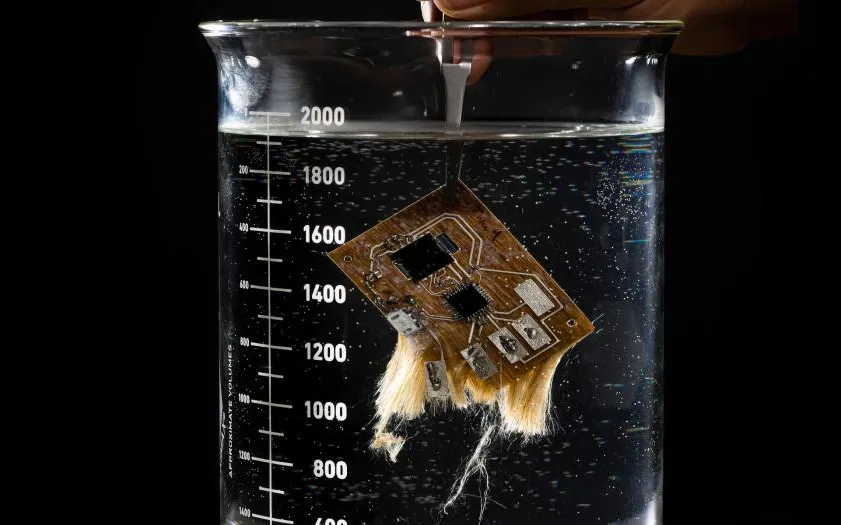Circuit Boards with Water-Soluble Properties Could Reduce Carbon Emissions by 60%
Infineon Technologies AG, a German semiconductor manufacturer, has revealed its production of a printed circuit board (PCB) that can dissolve in water. The Soluboard, sourced from UK startup Jiva Materials and made from plant-based materials, offers a potential solution for the technology industry to tackle e-waste and meet climate targets by 2030.
Jiva’s biodegradable PCB is made of natural fibers and halogen-free polymer, which has a much smaller carbon footprint than traditional boards made of fiberglass composites. In a 2022 study by the University of Washington College of Engineering and Microsoft Research, a team created an earth-friendly mouse using a Soluboard PCB as its core. The researchers found that Soluboard dissolved in hot water in less than six minutes. However, it can take several hours to break down at room temperature.
In addition to dissolving the PCB fibers, the process facilitates the recovery of the precious metals attached to it. “When [it dissolves], we’re left with chips and traces of circuits that we can filter out,” said UW assistant professor Vikram Iyer, who worked on the mouse project.
The video below shows Soluboard dissolving in a frying pan with boiling water:
♻️ We are adopting Soluboard®, a #recyclable & #biodegradable printed circuit board substrate based on natural fibers. It was designed by @JivaMaterials & the #organic structure allows the components of devices to dissolve when immersed in hot water. More: https://t.co/3yLMC5cuGh pic.twitter.com/mnWjPbSok7
— Infineon (@Infineon) July 28, 2023
“Implementing a water-based recycling process can lead to higher precious metal recoveries,” said Jonathan Swanston, CEO and co-founder of Jiva Materials. Jiva says the board has a 60 percent smaller carbon footprint than traditional circuit boards – specifically, it can save 10.5 kg of carbon and 620 g of plastic per square meter.
Infineon has produced three different circuit board prototypes using the Soluboard framework. The company currently only uses dissolvable PCB in demo and evaluation boards, and says it has about 500 units in use. However, it is “exploring the possibility of using the material on all discs” with an eye to expanding use over the next few years. Based on the results of the stress tests, it also plans to “provide guidelines for the reuse and recycling of power semiconductors removed from Soluboards” to reduce the chances of salvageable parts from future production models going to waste.




